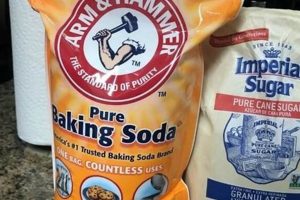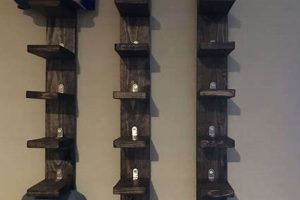A homemade solution for managing ant infestations focuses on creating traps from readily available materials. These traps are designed to attract and capture ants, thereby reducing their presence within a specific area. A common example involves using a mixture of borax and sugar in a container to lure ants, which then carry the poisoned bait back to their colony.
The significance of constructing these traps lies in their cost-effectiveness and reduced reliance on commercial pesticides. Utilizing a more natural approach benefits both the environment and potentially limits exposure to harmful chemicals within living spaces. Historically, individuals have sought self-sufficient methods for pest control, resulting in a variety of designs and techniques for effectively managing ant populations.
The following sections will delve into various methods of construction, optimal bait formulations, and strategic placement considerations to maximize the effectiveness of self-made ant control devices. This will provide readers with the necessary knowledge to create and deploy these traps, enabling a more sustainable approach to pest management.
Optimizing Homemade Ant Control Devices
The subsequent tips are designed to enhance the efficacy and longevity of self-constructed ant traps, ensuring more effective pest management.
Tip 1: Bait Freshness is Paramount: Prepare bait solutions in small batches to maintain their attractiveness. Stale or dried-out bait loses its appeal to foraging ants, rendering the trap ineffective. Regularly replace the bait solution, ideally every few days, or as needed.
Tip 2: Strategic Placement Matters: Position the traps in areas with high ant activity. Common locations include near entry points, along trails, and around food sources. Observe ant movement to identify the most effective placement zones.
Tip 3: Container Design Influences Access: Select containers with openings that are adequately sized for ants to enter easily. Avoid containers with overly deep or narrow openings that could deter entry. Small, shallow dishes or modified plastic containers often work best.
Tip 4: Consider Alternative Sweeteners: While sugar is a common attractant, other sweeteners such as honey or corn syrup can also be effective. Experiment to determine which sweetener the local ant population prefers for optimal attraction.
Tip 5: Manage Competing Food Sources: Eliminate or secure alternative food sources that may divert ants away from the trap. Clean up spills, store food in airtight containers, and remove crumbs to maximize trap effectiveness.
Tip 6: Dilution Ratios Impact Control: The concentration of borax in the bait solution is crucial. Too high a concentration can repel ants, while too low a concentration may not be lethal. Research and adhere to recommended dilution ratios for optimal results. A common starting point is a 1-2% borax solution.
Tip 7: Monitor and Adjust Placement: Periodically monitor trap activity. If ants are not actively feeding on the bait, adjust the trap placement or modify the bait solution. Continued monitoring and adjustment are essential for effective control.
Implementing these strategies maximizes the chances of successfully eliminating or controlling ant populations within a given environment, promoting a more pest-free living space.
The following sections will discuss the ecological impact and ethical considerations of ant control methods.
1. Material selection
The choice of materials is a fundamental consideration in the construction of homemade ant traps. Material properties directly influence the trap’s durability, suitability for various environments, and overall effectiveness in attracting and retaining target ant species.
- Container Durability and Longevity
The container material determines the trap’s resistance to degradation under environmental conditions. Plastic containers, while readily available, may degrade over time due to UV exposure or chemical interactions with the bait. Glass containers offer greater durability and resistance to chemical reactions but are susceptible to breakage. Selection should consider intended lifespan and potential environmental stressors.
- Bait Compatibility
Certain materials may react with the bait solution, altering its attractiveness or potency. Metallic containers, for instance, can interact with acidic bait components, potentially rendering the bait less effective. Non-reactive materials like plastic or glass are generally preferred to maintain bait integrity and palatability.
- Accessibility for Target Species
The texture and surface properties of the chosen material influence ant accessibility. Rough surfaces provide better grip for ants entering and exiting the trap, while smooth surfaces may hinder movement. Material selection should prioritize ease of access for the specific ant species being targeted, ensuring they can readily reach the bait.
- Environmental Impact
The environmental footprint of the chosen material is a crucial consideration for sustainable pest control. Biodegradable materials, such as cardboard or certain bioplastics, offer a more environmentally responsible option compared to non-biodegradable plastics. Selection should balance functionality with environmental impact, minimizing waste and promoting sustainable practices.
Therefore, a thoughtful approach to material selection is paramount in maximizing the efficacy and minimizing the environmental impact of homemade ant traps. Consideration of durability, bait compatibility, accessibility, and environmental impact contributes to a more effective and responsible approach to ant control.
2. Bait composition
The effectiveness of a homemade ant trap is inextricably linked to the formulation of the bait used within it. The composition dictates the trap’s attractiveness to foraging ants and the efficacy with which it eliminates the colony. The cause-and-effect relationship is straightforward: an appropriately formulated bait attracts ants, who then carry it back to the colony, leading to its demise; an ineffective bait fails to attract ants, rendering the trap useless. The bait is, therefore, a critical component, without which a self-constructed trap is merely an empty container.
A common example involves combining borax with a sugar solution. The sugar acts as an attractant, drawing ants to the bait, while the borax, a slow-acting poison, disrupts their digestive system. The crucial aspect is the ratio: too much borax repels the ants, while too little does not deliver a lethal dose. In practical terms, a homeowner might observe ants readily consuming a specific bait type, like honey mixed with boric acid, demonstrating its effectiveness. Conversely, they ma
y note that ants ignore a different combination, indicating a less palatable or repulsive formula.
Understanding the precise composition of the bait empowers individuals to create ant traps tailored to the specific preferences of local ant populations. While general recipes exist, observing ant behavior and experimenting with various ratios and ingredients is essential. Formulating an effective bait presents challenges, requiring careful consideration of toxicity, palatability, and the targeted ant species. However, by carefully considering and optimizing the bait formula, one can greatly improve the success of a do-it-yourself ant control strategy.
3. Placement strategy
Optimal positioning of homemade ant traps is paramount to maximizing their effectiveness. Thoughtful placement considers ant behavior, environmental factors, and access to resources. A poorly placed device, regardless of design or bait, will yield minimal results. Strategic deployment, therefore, represents a critical component of a successful ant management program.
- Proximity to Ant Trails and Nests
Locating traps along established ant trails increases the likelihood of discovery by foraging workers. Identifying entry points into structures and potential nest locations is equally crucial. Placing traps directly in these high-traffic areas ensures consistent exposure to the bait, accelerating colony impact. For example, locating a trap near a crack in a foundation wall, where ants are observed entering a home, drastically improves its efficacy.
- Consideration of Environmental Factors
Environmental conditions, such as moisture levels and temperature, influence ant activity and bait palatability. Placing traps in sheltered locations protects the bait from drying out or becoming diluted by rain. Avoiding direct sunlight prevents excessive heat, which can degrade the bait and deter ant foraging. These environmental factors must be considered to ensure traps remain attractive and accessible.
- Accessibility and Safety Considerations
Trap placement must balance accessibility for target ant species with safety considerations for non-target organisms, including pets and children. Elevated placement or the use of tamper-resistant containers prevents accidental ingestion or contact. Careful consideration of these factors minimizes the risk of unintended harm while maintaining effectiveness.
- Monitoring and Adjustment
Effective placement is not static; it requires continuous monitoring and adjustment based on ant activity. Observing ant foraging patterns and trap visitation rates allows for refinement of trap locations. If ants are not actively feeding on the bait, relocating the trap to a different area or adjusting the bait formulation may be necessary. Adaptability is essential for long-term success.
The interplay between placement strategy and the inherent design of self-made ant traps is undeniable. Strategic positioning amplifies the effectiveness of any given device, underscoring the need for careful observation, adaptability, and awareness of environmental and safety concerns. In essence, optimal placement ensures that even a rudimentary trap achieves its intended purpose: the targeted reduction of ant populations.
4. Trap Accessibility
Accessibility is a critical determinant of the effectiveness of any self-constructed ant trap. A device, regardless of its bait composition or strategic placement, will fail if ants cannot readily enter and exit to transport the bait back to the colony. The design must therefore prioritize ease of entry and egress for the target species.
- Entrance Size and Orientation
The dimensions of the entrance holes dictate which ant species can utilize the trap. Openings that are too small will exclude larger ants, while overly large entrances may expose the bait to non-target organisms or allow it to dry out too quickly. The orientation of the entrance also matters; downward-facing entrances can deter ants, while horizontal or slightly inclined entrances are generally more accessible. For example, small Argentine ants require significantly smaller entry points than larger carpenter ants.
- Surface Texture and Traction
The surface texture surrounding the entrance impacts an ant’s ability to grip and navigate the trap. Smooth surfaces, particularly those with steep inclines, can impede access, especially for ants carrying heavy loads of bait. Providing textured surfaces, such as roughened plastic or small ramps, enhances traction and improves accessibility. A slippery surface, on the other hand, can render a trap entirely useless.
- Internal Structure and Navigation
The internal layout of the trap must facilitate easy navigation to the bait source. Complex or convoluted pathways can disorient ants or deter them from proceeding. Simple, direct routes to the bait are generally more effective. Additionally, the height of the container and the presence of internal obstacles influence accessibility, especially for smaller ant species.
- Protection from Environmental Factors
Environmental conditions can affect trap accessibility. Rain, for instance, can flood the trap or dilute the bait, while excessive sunlight can cause it to dry out. Designing the trap with a roof or overhang protects it from these elements, maintaining a stable and accessible environment for ants to forage. Properly placed entrances can further aid in weatherproofing the trap, keeping it effective longer.
These design elements are interwoven and directly influence the operational efficiency of a homemade ant control mechanism. By carefully considering and implementing accessible designs, individuals can optimize the effectiveness of their traps and contribute to more successful pest management. Overlooking accessibility means the labor invested in bait selection and placement is rendered moot.
5. Safety precautions
Safety precautions represent a vital component in the construction and deployment of self-made ant traps. The materials used, the placement of traps, and the potential for unintended exposure necessitate careful consideration to mitigate risks to humans, pets, and the environment.
- Bait Toxicity and Handling
Many homemade ant baits incorporate substances that are toxic if ingested. Borax, boric acid, and other insecticides, while effective against ants, can pose a health hazard to children and pets. Secure bait placement out of reach of vulnerable individuals is crucial. Proper labeling of the trap with a clear warning about the presence of toxic substances is also advised. Always wear gloves during bait preparation and trap handling to avoid skin contact.
- Trap Stability and Integrity
Unstable or poorly constructed traps can pose a risk of spillage or collapse, leading to accidental exposure to the bait. Ensure the trap is constructed from durable materials and is stable on its intended surface. Regularly inspect the trap for damage or degradation, and promptly repair or rep
lace it as needed. A collapsed trap may also create a hazard for small animals, causing entrapment. - Environmental Contamination
Improper disposal of used ant traps can lead to environmental contamination. Do not discard traps in areas where they may leach toxic substances into the soil or water. Dispose of used traps in accordance with local regulations for hazardous waste. Consider using biodegradable materials for trap construction to minimize long-term environmental impact.
- Non-Target Species Exposure
While the intent is to target ants, other insects or small animals may inadvertently be attracted to the bait. Design trap entrances that are small enough to restrict access to larger creatures. Consider using bait formulations that are less attractive to non-target species. Regularly monitor the traps to ensure that only ants are accessing them, and adjust placement or design as needed.
The implementation of thorough safety measures is not merely a best practice; it is a fundamental responsibility when engaging in self-directed pest management. The potential benefits of homemade ant traps are negated if safety is compromised, leading to adverse consequences for human health or the environment. Therefore, prioritizing safety precautions is an intrinsic element of responsible trap construction and deployment.
6. Maintenance frequency
Maintenance frequency is a critical factor influencing the sustained effectiveness of homemade ant traps. Irregular or insufficient maintenance can compromise bait palatability, structural integrity, and overall efficacy, thereby diminishing the trap’s ability to control ant populations.
- Bait Replenishment and Freshness
Ant baits degrade over time, losing their attractiveness to foraging ants due to evaporation, mold growth, or chemical decomposition. Regular bait replenishment, typically every few days or weeks depending on environmental conditions, is essential to maintain its effectiveness. A dried-out or contaminated bait will fail to attract ants, rendering the trap useless. For example, a sugar-borax solution exposed to high humidity may ferment, becoming repellent to ants rather than attractive.
- Trap Cleaning and Sanitation
Accumulation of dead ants, debris, or mold within the trap can deter other ants from entering. Periodic cleaning with a mild detergent removes these contaminants, restoring the trap’s attractiveness. Neglecting sanitation can create an unhygienic environment that repels target insects and potentially attracts other pests. This involves carefully removing dead ants without scattering them around the location of the trap. The container is then rinsed and refilled with fresh bait.
- Structural Integrity Assessment
Homemade traps are susceptible to damage from environmental factors or accidental impact. Routine inspection for cracks, leaks, or structural weaknesses is necessary to ensure bait containment and prevent accidental spills. A compromised trap can release toxic bait into the surrounding environment, posing a risk to non-target organisms. If the container is damaged, it needs replacing and reinstalling on the same location.
- Placement Verification and Readjustment
Ant foraging patterns can shift over time due to changes in food availability or environmental conditions. Regular observation of ant activity around the trap allows for timely readjustment of its placement. If ants are no longer visiting the trap, it may need to be moved to a new location with higher ant traffic. A successful placement strategy demands constant monitoring and adjustment, ensuring that the trap remains in an optimal position for intercepting foraging ants. This might also mean adding more of the diy ant catchers, so ants can be eliminated much faster.
In summary, consistent maintenance directly influences the longevity and effectiveness of homemade ant traps. By prioritizing bait freshness, sanitation, structural integrity, and placement verification, individuals can optimize trap performance and achieve sustained control of ant populations, leading to a significant reduction in the need for commercial pest control interventions. By consistently doing this and putting more efforts, diy ant catcher can be as great as a professional one.
7. Environmental impact
The construction and deployment of self-made ant traps, while often viewed as a benign alternative to commercial pesticides, carry environmental implications that warrant careful consideration. The materials used, bait composition, and disposal methods collectively influence the ecological footprint of this pest control approach. A comprehensive understanding of these factors is crucial for minimizing potential harm and promoting sustainable practices.
One significant concern involves the use of potentially harmful substances in bait formulations. While borax and boric acid are frequently employed due to their effectiveness against ants, they can also pose a threat to non-target organisms if improperly handled or disposed of. Leaching of these substances into the soil or water can negatively impact plant growth and aquatic ecosystems. Conversely, utilizing biodegradable materials for trap construction reduces long-term environmental burden compared to non-degradable plastics. Employing baits with natural attractants, such as sugar or honey, coupled with lower concentrations of active ingredients can mitigate the risk to beneficial insects and other wildlife. The effect is clear: a trap constructed with sustainable materials and carefully formulated bait presents a substantially lower environmental risk.
Ultimately, a responsible approach to constructing ant traps necessitates a holistic evaluation of their environmental impact. By prioritizing biodegradable materials, minimizing the use of toxic substances, and implementing proper disposal methods, individuals can significantly reduce the ecological footprint of their pest control efforts. Awareness of this interconnectedness fosters a transition toward more sustainable and environmentally conscious ant management practices, contributing to the preservation of ecological balance.
Frequently Asked Questions
The following section addresses common inquiries regarding the construction, deployment, and effectiveness of homemade ant traps, offering clarification and practical guidance.
Question 1: What constitutes the most effective bait for attracting ants to homemade traps?
The optimal bait composition varies depending on the ant species and local food sources. However, a common and generally effective formulation consists of a mixture of borax (or boric acid) and sugar water, typically in a ratio of approximately 1:3 or 1:4. Experimentation may be necessary to determine the preferred bait composition for a specific ant population.
Question 2: Where should homemade ant traps be strategically placed to maximize their effectiveness?
Traps should be positioned in areas with high ant activity, such as along known ant trails, near entry points into structures, and around identified food sources. Placement in damp or shaded locations may also enhance attractiveness. Monitoring trap activity and adjusting placement as needed is essential.
Question 3: How
frequently should homemade ant traps be maintained and replenished?
Bait should be replenished regularly, typically every few days to once a week, depending on evaporation rates and ant activity. Traps should also be cleaned periodically to remove dead ants and debris, ensuring continued attractiveness and accessibility.
Question 4: Are homemade ant traps safe for use around children and pets?
Homemade ant traps can pose a risk to children and pets due to the presence of toxic substances in the bait. Traps should be placed out of reach of vulnerable individuals or enclosed in tamper-resistant containers to prevent accidental ingestion. Proper labeling and handling are also crucial.
Question 5: What materials are suitable for constructing durable and effective homemade ant traps?
Suitable materials include plastic containers, glass jars, or cardboard boxes. The chosen material should be non-reactive with the bait solution and provide easy access for ants. Durability and resistance to environmental degradation are also important considerations.
Question 6: How long does it typically take to see results from homemade ant traps?
The time required to achieve noticeable results varies depending on the size of the ant colony, the effectiveness of the bait, and the strategic placement of the traps. Visible reductions in ant activity may be observed within a few days to several weeks. Continued monitoring and maintenance are necessary for long-term control.
In summary, success with homemade ant traps depends on a combination of effective bait formulation, strategic placement, consistent maintenance, and careful consideration of safety concerns. This information contributes to a more informed approach to pest management.
The following section delves into advanced strategies for optimizing homemade ant trap designs.
DIY Ant Catcher
This exploration of “diy ant catcher” methods has underscored several key aspects: effective construction hinges on appropriate material selection, strategic placement is crucial for intercepting foraging ants, and bait composition dictates attraction and efficacy. Furthermore, safety precautions are paramount to prevent unintended harm to humans and non-target species, while consistent maintenance ensures sustained control. Addressing these elements collectively contributes to the successful implementation of these homemade pest management solutions.
The information presented serves as a foundation for informed decision-making in ant control. Further research and adaptation to local ant species and environmental conditions are encouraged. Implementing these approaches with diligence and a commitment to minimizing environmental impact will yield the most favorable and responsible outcomes. The effectiveness of “diy ant catcher” strategies relies heavily on continuous monitoring and improvements.







